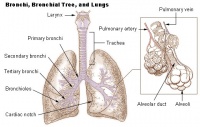Bronchiolitis: Difference between revisions
No edit summary |
No edit summary |
||
| Line 33: | Line 33: | ||
*Nebulized hypertonic saline | *Nebulized hypertonic saline | ||
*Glucocorticoids | *Glucocorticoids | ||
*Chest physiotherapy | *Chest physiotherapy<br> | ||
== Key Evidence == | == Key Evidence == | ||
| Line 51: | Line 47: | ||
<rss>Feed goes here!!|charset=UTF-8|short|max=10</rss> | <rss>Feed goes here!!|charset=UTF-8|short|max=10</rss> | ||
</div> | </div> | ||
== References<br> == | == References<br> == | ||
<references /> | <references /> | ||
Revision as of 15:04, 8 March 2016
Original Editor - Jerome Ng
Top Contributors - Jerome Ng, Kim Jackson, Donald John Auson, Wendy Snyders, Naomi O'Reilly, WikiSysop, Adam Vallely Farrell, Vidya Acharya and Candace Goh
Clinically Relevant Anatomy
[edit | edit source]
Bronchiolitis is inflammation of the bronchioles, the smallest air passages of the lungs, in which air passes through the nose or mouth to the alveoli of the lungs where gas exchange takes place.
Mechanism of Injury / Pathological Process
[edit | edit source]
Bronchiolitis typically occurs with primary infection or reinfection with a viral pathogen, but occasionally is caused by bacteria (eg, Mycoplasma pneumoniae). In young children, the clinical syndrome of bronchiolitis may overlap with recurrent virus-induced wheezing and acute viral-triggered asthma.
Clinical Presentation[edit | edit source]
Bronchiolitis is a major cause of illness and hospitalization in infants and children younger than two years. Symptoms include:
- Persistently increased respiratory effort (tachypnea, nasal flaring, intercostal or suprasternal retractions, accessory muscle use, grunting)
- Hypoxemia
- Apnea
- Acute respiratory failure
Management / Interventions
[edit | edit source]
- Hydration
- Respiratory support
- Nasal suctioning
- Supplemental oxygen
The following are interventions that may be used, but not as a routine intervention:
- Trial of inhaled bronchodilator
- Nebulized hypertonic saline
- Glucocorticoids
- Chest physiotherapy
Key Evidence[edit | edit source]
In the Cochrane review titled "Chest physiotherapy for acute bronchiolitis in children younger than two years of age", it was concluded that none of the chest physiotheray techniques (vibrations, percussions, slow passive expiratory techniques or forced expiratory techniques) have demonstrated a reduction in the severity of disease. Hence, these tecniques cannot be used as standard clinical practice for hospitalised patients with severe bronchiolitis.[1]
Case Studies[edit | edit source]
add links to case studies here (case studies should be added on new pages using the case study template)
Recent Related Research (from Pubmed)[edit | edit source]
Extension:RSS -- Error: Not a valid URL: Feed goes here!!|charset=UTF-8|short|max=10
References
[edit | edit source]
- ↑ Roqué i Figuls M, Giné-Garriga M, Granados Rugeles C, Perrotta C, Vilaró J. Chest physiotherapy for acute bronchiolitis in paediatric patients between 0 and 24 months old. Cochrane Database of Systematic Reviews 2016, Issue 2. Art. No.: CD004873. DOI: 10.1002/14651858.CD004873.pub5.







